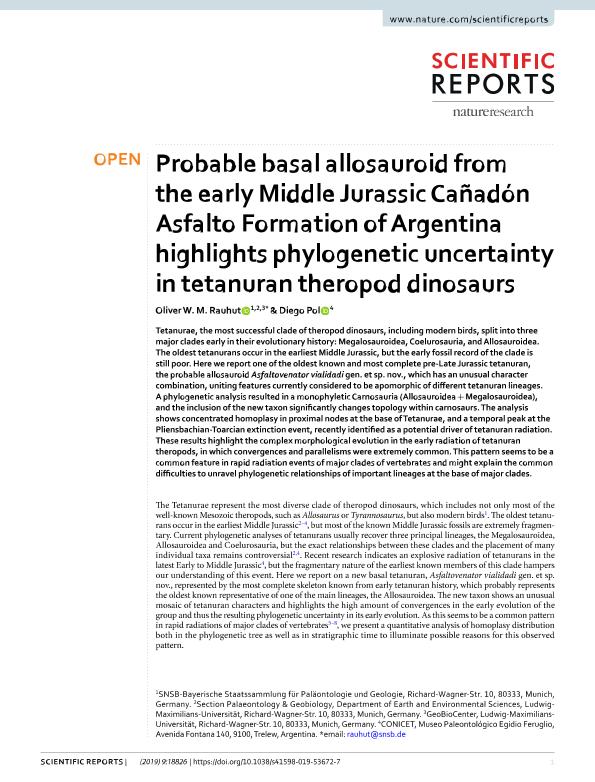Artículo
Probable basal allosauroid from the early Middle Jurassic Cañadón Asfalto Formation of Argentina highlights phylogenetic uncertainty in tetanuran theropod dinosaurs
Fecha de publicación:
12/2019
Editorial:
Nature Publishing Group
Revista:
Scientific Reports
e-ISSN:
2045-2322
Idioma:
Inglés
Tipo de recurso:
Artículo publicado
Clasificación temática:
Resumen
Tetanurae, the most successful clade of theropod dinosaurs, including modern birds, split into three major clades early in their evolutionary history: Megalosauroidea, Coelurosauria, and Allosauroidea. The oldest tetanurans occur in the earliest Middle Jurassic, but the early fossil record of the clade is still poor. Here we report one of the oldest known and most complete pre-Late Jurassic tetanuran, the probable allosauroid Asfaltovenator vialidadi gen. et sp. nov., which has an unusual character combination, uniting features currently considered to be apomorphic of different tetanuran lineages. A phylogenetic analysis resulted in a monophyletic Carnosauria (Allosauroidea + Megalosauroidea), and the inclusion of the new taxon significantly changes topology within carnosaurs. The analysis shows concentrated homoplasy in proximal nodes at the base of Tetanurae, and a temporal peak at the Pliensbachian-Toarcian extinction event, recently identified as a potential driver of tetanuran radiation. These results highlight the complex morphological evolution in the early radiation of tetanuran theropods, in which convergences and parallelisms were extremely common. This pattern seems to be a common feature in rapid radiation events of major clades of vertebrates and might explain the common difficulties to unravel phylogenetic relationships of important lineages at the base of major clades.
Palabras clave:
Jurassic
,
Theropoda
,
Dinosauria
,
Patagonia
Archivos asociados
Licencia
Identificadores
Colecciones
Articulos(SEDE CENTRAL)
Articulos de SEDE CENTRAL
Articulos de SEDE CENTRAL
Citación
Rauhut, Oliver Walter Mischa; Pol, Diego; Probable basal allosauroid from the early Middle Jurassic Cañadón Asfalto Formation of Argentina highlights phylogenetic uncertainty in tetanuran theropod dinosaurs; Nature Publishing Group; Scientific Reports; 9; 1; 12-2019; 1-9
Compartir
Altmétricas




